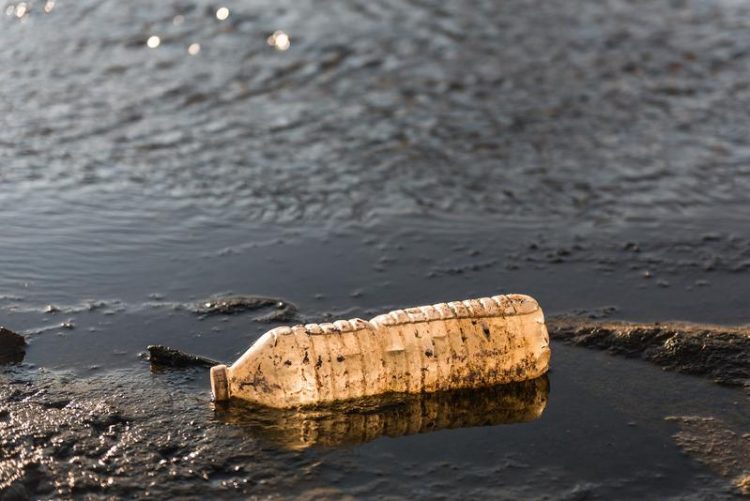5000 tons of plastic released into the environment every year

Plastic in the Environment Bernd Nowack / Empa
The Empa study focused on specific types of plastic: polyethylene (LD-PE and HD-PE), polypropylene, polystyrene and expanded polystyrene, PVC and PET used for example in packaging, textiles, insulation materials and agricultural films.
The researchers followed the path of these plastics to the Swiss environment from production through use to disposal and developed a model, with which these material flows can be calculated. They distinguish between microplastics (smaller than 5 millimeters) and macroplastics (larger than 5 millimeters).
Overall, around 5,120 tons of the seven types of plastic are discharged into the environment each year. This is around 0.7% of the total amount of the seven plastics consumed in Switzerland each year (amounting to a total of around 710,000 tons). According to Empa's modelling, around 4,400 tons of macroplastic are deposited on soils every year.
In addition, about 100 tons of macroplastic are emitted to waters. 600 tons of microplastics end up in or on soils and about 15 tons in waters. The amount of microplastics is thus much smaller than that of macroplastics; in contrast, the number of microplastic particles that could have an impact on organisms is much larger.
For an overall picture of plastic pollution in Switzerland, however, tire abrasion should also be taken into account. Several studies have identified this material as the largest source of microplastics. A current study at Empa will provide further information on this source of plastic pollution.
40-times more plastic in soils than in waters
The investigation of the seven types of plastic shows that the amount of plastic that gets into the soil is about 40-times higher than the amount that is discharged into water bodies. The main reason for this is littering – the careless throwing away of waste –, which pollutes in particular soils, but also waters, with macroplastics.
The cleaning of public spaces allows the collection of a large part of this plastic. Nevertheless, part of it remains lying around. Another significant source of macroplastic in soils is the use of plastic films in agriculture. Macroplastic also reaches the soils through the composting of organic waste that contains plastic.
The most important sources of microplastics in soils are agriculture and the construction industry, for example through the wear and tear of foils and pipes and the installation and dismantling of insulation on houses. To a lesser extent, waste disposal also contributes to microplastic pollution by shredding plastic waste for recycling.
The main sources of microplastics in waters are the washing and wearing of synthetic fiber clothing as well as cosmetics. Measured against the modelled soil contamination, however, these sources appear low.
In addition, efficient wastewater treatment plants filter a large part of microplastic out of the wastewater. A recent Empa study has shown that currently microplastics pose no threat to aquatic organisms in Europe.
Research projects and measures for the future
Empa's calculations make it possible to identify future areas of research and action. In particular, the plastic contamination of soils should be investigated more thoroughly.
Depending on the type of plastic used, there are various options for action: Consumers must be made even more aware of the fact that disposable packaging should be disposed of as waste.
Improved cleaning measures, for example along roads, prevent the pollution of the environment with discarded waste. In agriculture, the input of plastics into the soil must be reduced. In the waste and construction industries, companies should be made aware of the issue of plastic pollution.
At the political level, several initiatives are calling for measures to be taken in the field of plastics. The FOEN is currently considering further steps to reduce the environmental impact of plastics.
Prof. Dr. Bernd Nowack, Empa, Technologie und Gesellschaft, Tel. +41 58 765 76 92, Bernd.Nowack@empa.ch
Dr. Michael Hagmann, Empa, Kommunikation, Tel. +41 58 765 45 92, redaktion@empa.ch
Bundesamt für Umwelt (BAFU), Sektion Medien, Tel. +41 58 462 90 00, medien@bafu.admin.ch
D Kawecki, B Nowack; Polymer-Specific Modeling of the Environmental Emissions of Seven Commodity Plastics As Macro- and Microplastics; Environ Sci Technol (2019); doi: 10.1021/acs.est.9b02900
Media Contact
All latest news from the category: Ecology, The Environment and Conservation
This complex theme deals primarily with interactions between organisms and the environmental factors that impact them, but to a greater extent between individual inanimate environmental factors.
innovations-report offers informative reports and articles on topics such as climate protection, landscape conservation, ecological systems, wildlife and nature parks and ecosystem efficiency and balance.
Newest articles
Humans vs Machines—Who’s Better at Recognizing Speech?
Are humans or machines better at recognizing speech? A new study shows that in noisy conditions, current automatic speech recognition (ASR) systems achieve remarkable accuracy and sometimes even surpass human…

Not Lost in Translation: AI Increases Sign Language Recognition Accuracy
Additional data can help differentiate subtle gestures, hand positions, facial expressions The Complexity of Sign Languages Sign languages have been developed by nations around the world to fit the local…

Breaking the Ice: Glacier Melting Alters Arctic Fjord Ecosystems
The regions of the Arctic are particularly vulnerable to climate change. However, there is a lack of comprehensive scientific information about the environmental changes there. Researchers from the Helmholtz Center…



